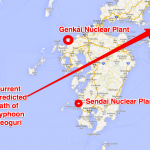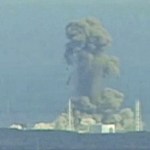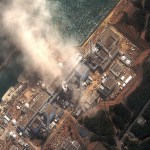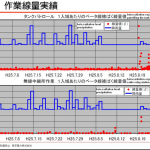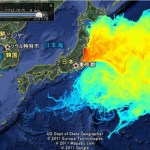Fukushima
Great disasters are great stories, great moments in time, great tests of technology, humanity, society, government, and luck. Fifty years ago it was probably true to say that our understanding of great disasters was thin, not well developed because of the relative infrequency of the events, and not very useful, not knowledge that we could use to reduce the risks from such events.
This is no longer true. The last several decades has seen climate science add more climatic data because of decades of careful instrumental data collection happening, but also, earlier decades have been added to…
Three years after the disaster at Fukushima, science correspondent Miles O'Brien returned to the Daiichi nuclear plant for an exclusive look at the site. Follow Miles on a never-before-seen tour of Daiichi's sister site, Fukushima Daini, which narrowly avoided a meltdown during the Tohoku earthquake. As the country debates turning its reactors back on, Miles asks: will Japan have a nuclear future?
Update:
The new forecast track of Neoguri is shown above as well as the location of two nuclear power plants.
The forecast track has moved south, and is now in a very good (and here good means bad) position to strike the Sendai nuclear power plant very directly. Keep in mind that this forecast may change.
On Tuesday mid day UTC the storm will likely be in the later phases of a turn to the right, aiming roughly at the Sendai plant. At this point maximum wind speed near the center of the storm will likely be about 90 mph, which puts the storm in the middle of the Category One range. That…
On March 11th, 2011, a large earthquake caused a large tsunami in Japan, and the two historic events wrecked the Fukushima Daiichi nuclear power plant. The power plant had six boiling water reactors of the kind used around the world in many nuclear power plants. Three of the six reactors suffered a meltdown, and containment structures meant to contain a meltdown were also breached. This is regarded as one of the worst nuclear disasters to ever happen, possibly the worst of all, though comparing major nuclear disasters to each other is hard for a number of reasons.
As you know if you are a…
TEPCO is removing some of those famous spent fuel rod assemblies, here's some video:
TEPCO was going to start removing the fuel rods from the less-damaged reactor building Numnber 4 over the next few days. Today, it was announced that damage to the fuel rod assemblies, some or most of which predated the tsunami and earthquake, this could not be done. There is now uncertainty as to what is going to happen.
Here is a video by Fairewinds about this operation, which I believe was made before TEPCO decided to not continue with the removal at this time:
As you can see, there are several possible problems. Most of these problems are not related to the reasons TEPCO has given to…
Fukushima Update #70: If you can't measure it, you can't analyze it.
by Analiese Miller and Greg Laden
It has been suggested, by various commenters on the internet, that the problem with Fukushima is not that there is a dangerous radioactive mess there, but rather, that the authorities in charge have decided that exposure to radiation is dangerous, when it really isn’t. The argument has been made that the evacuation of the region around Fukushima at the time of the meltdowns and explosions was unnecessary. This presumably also means that the exclusion zones, where people are not allowed to…
Patrick J. Kiger at National Geographic News has an excellent summary of the current situation at Fukushima Daiichi Nuclear Power Plant. The plant continues to leak radioactive material into the sea, though at a rate much lower than the massive release that happened at the time of the accident. Strontium-90 (Half-life 28.79 years) has increased in proportion over various Cesium isotopes. This is a concern because while Cesium has the potential to enter the food supply in fish that pick it up, Strontium enters the food supply in a different way. In theory Cesium enters tissues and leaves…
On March 11th, 2011, the Fukushima Daiichi nuclear power plant complex suffered damage from an earthquake and ensuing tsunami that caused multiple nuclear reactor core meltdowns and melt-throughs, explosions, and major releases of radioactive material into the air and the sea. In addition to the reactor meltdowns and melt-throughs spent fuel storage tanks were also damaged and probably contributed to the release. It took about a year for the plant to reach a condition that was stable enough that we stopped checking it every day to see if new bad things were happening. Heroic efforts were…
By Larry Bock
Founder and organizer, USA Science & Engineering Festival
When searching for a prime, real-life example of how science and technology are making a difference in the world right now, my thoughts lately turn to a small but feisty greentech startup that you may never have heard of: Kurion, Inc.
Based in Irvine, CA with 15 employees, this profitable three-year-old company which specializes in nuclear waste cleanup has quietly and effectively been using its technology at the front lines of Fukushima, the site of what is being called one of the largest nuclear disasters in…
by Fred Bortz, author of Meltdown! The Nuclear Disaster in Japan and Our Energy Future (Twenty-First Century Books, 2012)
A year ago this week, on March 11, 2011, the biggest earthquake in Japan's history devastated the Tohoku region, 320 kilometers northeast of Tokyo. In the huge tsunami that followed, more than 13,000 people drowned, and thousands of buildings and homes were reduced to rubble.
Within hours, horrifying photos and videos spread around the world. But the most frightening news was yet to come. The Fukushima Dai'ichi nuclear power plant was seriously damaged and three of its…
by Mark Pendergrast
This is my third and final post about the state of Japan's renewable energy efforts and other measures that are vital to prevent further climate change and to wean the country from fossil fuel and nuclear power. In my first post, I covered the public-health impacts of climate change and explained why Japan is good indicator of whether countries will be able to act quickly enough in the face of these threats. Japan's reliance on imported fossil fuels gives it a good reason to invest in alternatives, and its technological sophistication should help it develop renewable-…
by Mark Pendergrast
This is my second post in a series of three about the state of Japan's renewable energy efforts, which are vital to prevent further climate change and to wean the country from fossil fuel and nuclear power. In the previous post, I covered the public-health impacts of climate change and explained why Japan is a good indicator of whether countries will be able to act quickly enough in the face of these threats. Japan's reliance on imported fossil fuels gives it a good reason to invest in alternatives, and its technological sophistication should help it develop renewable-…
by Mark Pendergrast
I'm going to talk about Japanese renewable energy in a minute, but first let me explain why.
In 2010, I published a book on public health (Inside the Outbreaks), and as a follow-up, I concluded that the overarching threat to the world's public health that we face in the coming decades is climate change, for a number of reasons. According to most scientists, three trends will conflate to create substantial problems. 1) We will run out of oil. 2) Climate change will have a profound impact on the environment and our lives. 3) The world's population will grow from 7…
The Fukushima nuclear power plant was opened to journalists for the first time; See below for numerous links to related stories.
There appears to be very high levels of radiation at Fukushima plant reactor #3, and at either reactors 1 and 3, or both, nuclear fission may have been occurring in the melted down remains. Ideally, once a plant is turned off, i.e., control rods inserted etc. etc., the state of "criticality" is stopped and there is no more fission, or at least, only a small background level. But, if a nuclear power plant's core melts down, nuclear material can re-accumulate in…
One of the interesting items we have this week is a study by Greenpeace in which various organisms from the sea near Fukushima were sampled for radioactive isotopes. Let's take a closer look.
The data in the table provided (see the first item in Ana's feed for the link) show the amount of radiation (radioactive decay) by isotope type per kilogram of plant or animal tissue from various samples. On the higher end is a fish with 357 bq/kg of radiation and some seaweed with 190 bk/kg.
What does this mean? Hard to say. I can tell you this: A normal human has about 4,000 or more bq (in total…
Today all we have for you is Ana's feed, and only the first half. We have both been very busy with distracting things like work and other writing projects and so on. There are interesting things going on at Fukushima and in the Nuclear Power industry in general, as you'll see soon. In the mean time, here's what has been happening:
Fight Over Mining Near Grand Canyon, Other Riders Will Return After Recess -NYT, August 9
-Several lawmakers involved in the congressional debate over uranium mining around the Grand Canyon expect the war of words to reignite as soon as the House returns from…
This post is more an appeal for info than anything useful in itself. But I'll probably update it if I get anything. Fukushima refers. My question, in the context of the area around Fukushima that is contaminated by radioactivity, is
how much is actually contaminated, in the sense of now having radioactivity levels higher than naturally occurs in granite-based areas like Cornwall? How much has been officially declared "contaminated" isn't a very interesting number
In response, M points me to radioactivity.mext.go.jp/en/distribution map around FukushimaNPP/; here for example is July 2011 (take…
The Fukushima stuff was all very exciting, and doubtless still is if you live nearby (James?). But it does seem to lead to high levels of drivel from the more soppy-hand-wringing Guardianista types:
We had a pretty good warning earlier this year, when the tragic earthquake and tsunami in Japan caused an even bigger tragedy when the Fukushima nuclear power plant suffered a meltdown
The tsunami killed 20k people, or whatever. Fukushima killed no-one, directly, though it wouldn't be surprising if it kills a few eventually. So why was Fukushima an "even bigger tragedy"? Perhaps Kate Sheppard is…
Though the disaster at Japan's Fukushima Daichi nuclear plant has faded from the headlines, cleanup work continues amid high radiation levels. TIME's Krista Mahr reports that Japan's Ministry of Economy, Trade and Industry has just released a document that includes an April estimate that 1600 workers will be exposed to high levels of radiation while working to stabilize the plant. Japan's government raised the exposure limit from 100 millisieverts per year to 250 after this disaster occurred; the just-released document expresses concern that if too many workers reach this limit working at…

